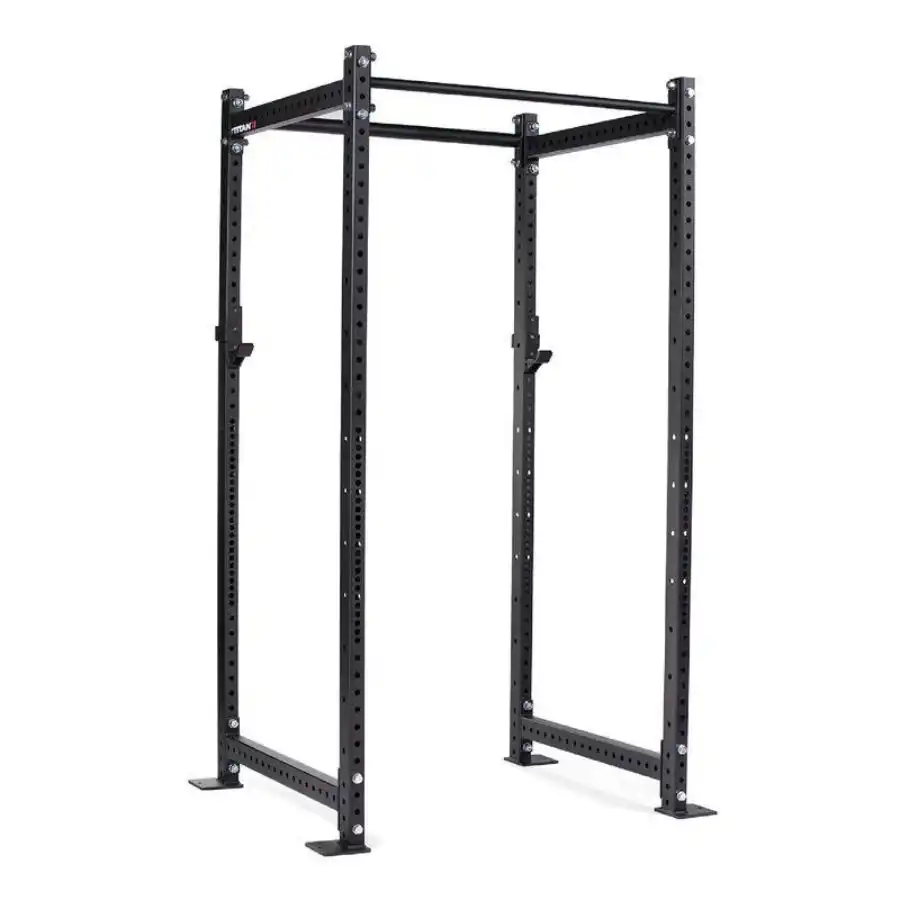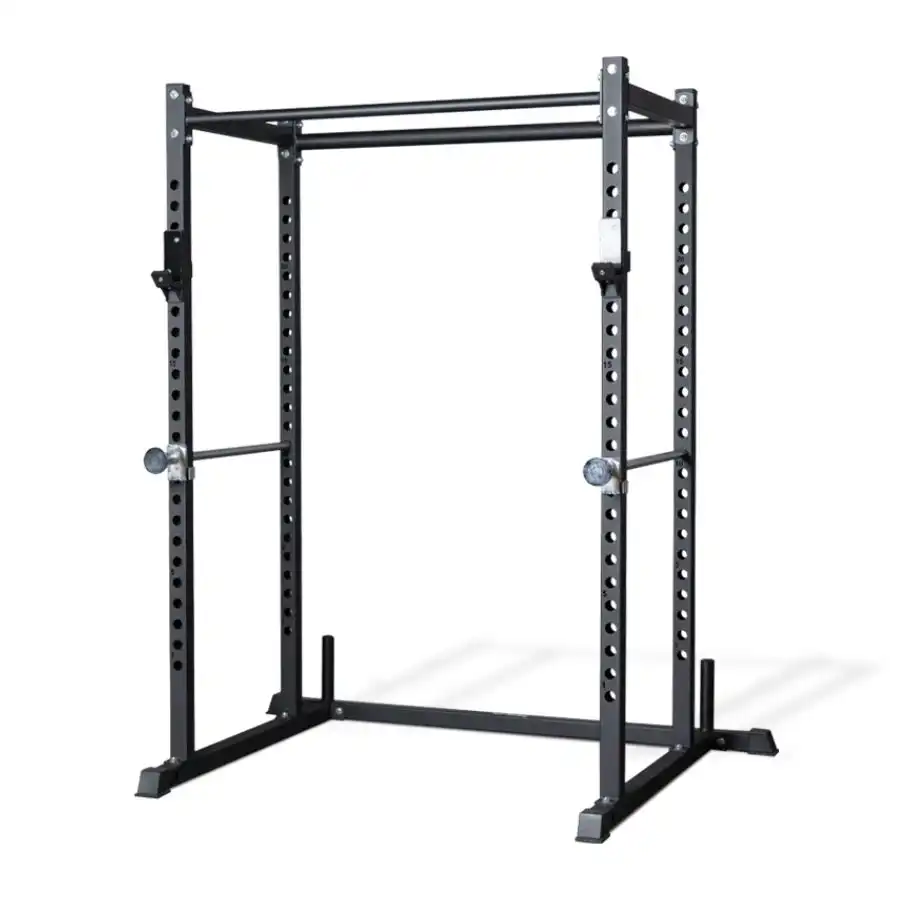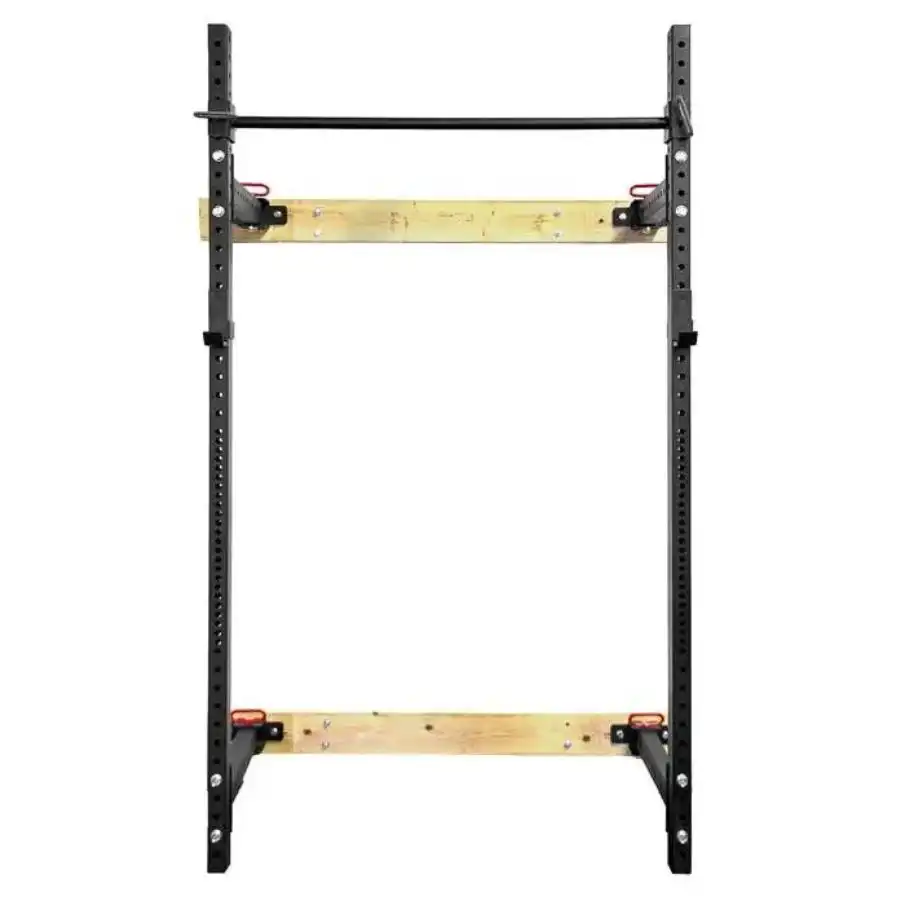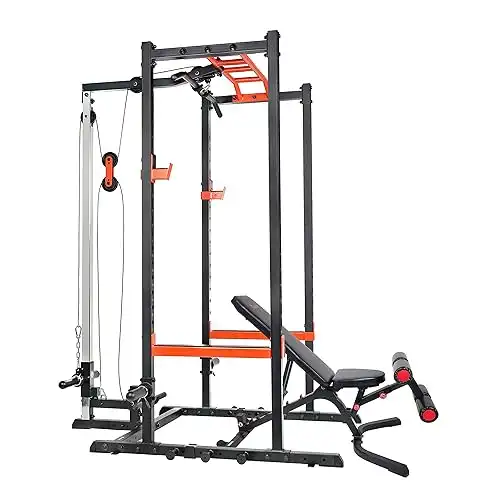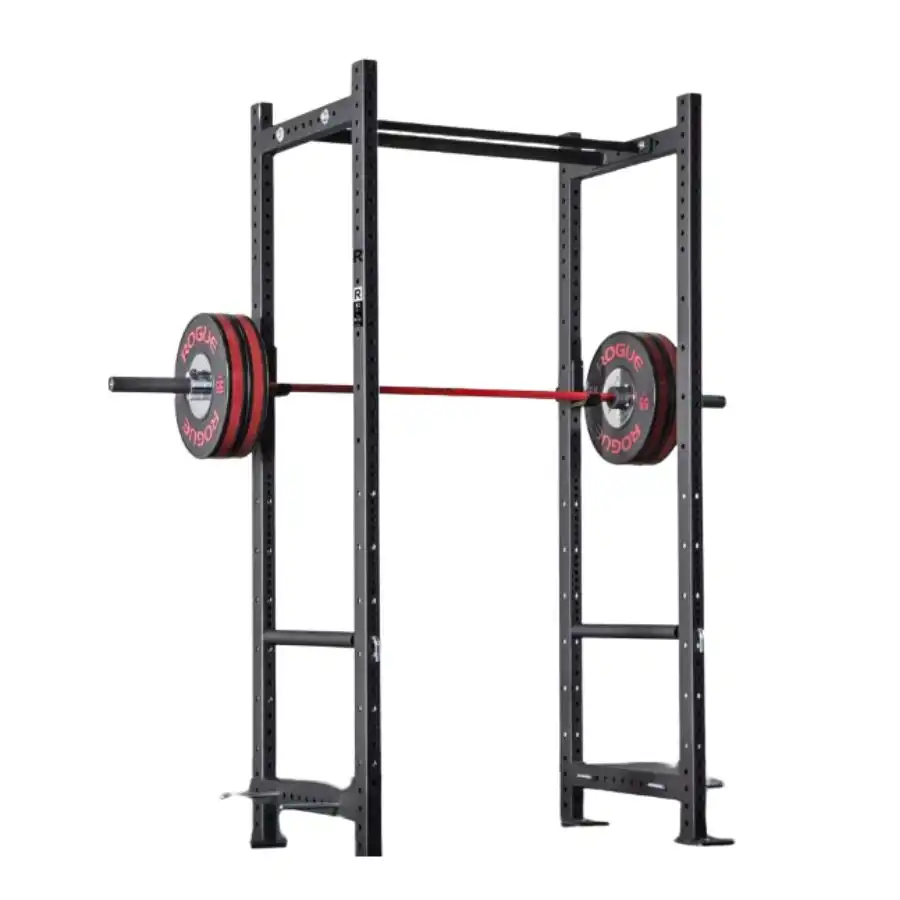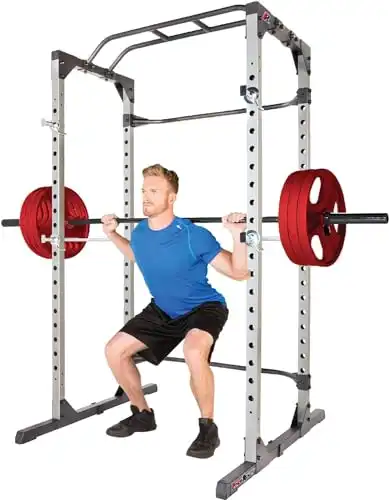A power rack allows you to safely perform weightlifting exercises like barbell squats and bench presses, without a spotter, in your home gym. Add-on accessories like pull-up bars, dip stations, and resistance bands can help you get the most out of your power rack, giving you the tools for a versatile full-body workout.
Whether you have limited space or are looking for a budget-friendly power rack, there are options that may work for you. We compiled a list of the best power racks for your home gym with all the details you need to find the right equipment to take your fitness routine to the next level in 2024. Shane Sevcik—a USAW-1 (USA Weightlifting) certified coach, current USA Weightlifting Foundation board member, state record holder, and Masters Pan American and World title holder—also shares his insights into what to look for in power racks.
Our Picks for the Best Power Racks of 2025
This content is meant to be informative, but should not be taken as medical advice. It is not intended for use as diagnosis, prevention, or treatment of health problems. Always speak with your doctor before starting any new supplement or exercise regimen.
Best Overall Power Rack: REP Fitness PR-1000 Power Rack
Pros:
- Built-in weight storage pegs help you stay organized and add stability to the base
- Dual pull-up bars with varying thicknesses for versatility
- Chrome-coated safeties and powder-coated steel resist rust
- Laser-engraved numbered uprights
- Plastic-lined J-hooks to protect your barbell
Cons:
- May feel shaky when using heavier weights
- 14-gauge steel is less thick than other options on this list
The REP Fitness PR-1000 Power Rack has a four-post frame made from 14-gauge steel with laser-cut holes spaced two inches apart. There are two pull-up bars—one is 1.25 inches thick, and the other is two inches thick—so you can do accessory work such as pull-ups and grip exercises without using additional space or buying a separate piece of equipment. The pull-up bars are strategically placed on the rack, spanning the front and back posts, contributing to the overall stability. There are built-in weight storage pegs on the back base for additional sturdiness. You can customize the rack using multiple accessory options such as safety straps, a dip station, and more.
Tester Brandon Lunsford, C.P.T., CF-L1, used this rack to do exercises like squats, bench press, strict press, pull-ups, and more for almost two years. He describes it as an intermediate or beginner rack and noticed movement while un-racking 350 pounds. “The rack held the weight just fine, but there was some swaying after I removed the bar. I’d recommend it to a beginner or someone who doesn’t lift to that capacity because I was happy with it otherwise.”
We like that the PR-1000 comes with chrome-coated safeties extending past the rack, offering an additional place for a barbell. The numbered uprights allow you to adjust the safeties or J-hooks quickly and never have to worry about your bar being crooked. “The J-hooks were easy to move, and the hole spacing of one inch is adequate to get the bar lined up where you need it,” Lunsford says. “I can attest to the functionality of the safeties; they worked great for me when I failed a heavy bench over 250 pounds.”
Best Folding Power Rack: Titan Fitness T-3 Series Folding Power Rack
Titan T-3 Series Power Rack
4.3
- Dimensions: 46″ outside width; 24″ or 36″ inside depth; 82″ or 91″ height
- Materials: 2×3, 11-gauge steel
- Weight capacity: 1,100 pounds
- Hole spacing: Westside
Pros:
- Foldable
- Westside hole spacing allows for precise adjustability
- Weight capacity of 1,100 pounds is on the higher end compared to other power racks on this list
- Reinforced J-cups have a protective lining
- Different heights to accommodate your space
Cons:
- Safety bars not included
- Two-inch-by-three-inch tubing may not work with accessories purchased from other brands
The Titan Fitness T-3 Series Power Rack is a wall-mounted power rack that folds to a closed position, which only sticks out five inches from the wall. The bolt-down uprights and side bracings keep it stable, so you feel comfortable lifting weights to 1,100 pounds. Those who want to use the dual pull-up bars for dynamic movements such as kipping pull-ups or toes-to-bar benefit from the added stability the floor attachment provides. The rear pull-up bar is two inches thick, and the front pull-up bar is the industry standard of 1.25 inches thick.
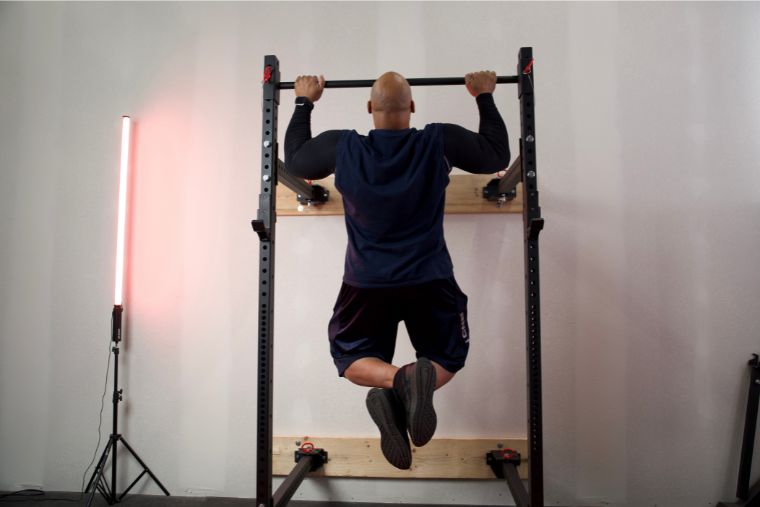
This rack is made from 11-gauge steel and features two-inch by three-inch tubing. Typically, newer racks have three-inch by three-inch steel tubing, so attachments from other brands may not work. Lunsford says, “A rack is an essential piece of fitness equipment. What sets them apart is the build, value, and accessories. A full power rack of this style with a weight capacity of 1,100 pounds for around $400 is an excellent bang for the buck.”
Lunsford says the brand uses manufacturing processes to elevate the overall quality. “The holes are laser cut instead of punched, and the brand uses robot welders instead of guides operated by humans.” This technique allows for more efficiency, precision, and consistency in enhanced craftsmanship. The laser-cut holes are two inches apart, and the bench and clean pull zone have Westside hole spacing—holes in the upright that are closer together for more precise positioning.
Free shipping is available on all Titan products, and a one-year warranty covers manufacturing defects and issues that may arise while using the product. One callout we have is the rack does not come with safety arms, which range in price from $90 to $190, depending on which type you get. The rackable weight capacity is 1,100 pounds, but the included J-cups are rated up to 1,000 pounds, so if you want to move heavier weights, you’ll need to upgrade the J-cups.
Titan offers several accessories for purchase separately, including safety bars or straps, stabilizer feet, spotter arms, pin and pipe safety set, or an extension kit to upgrade to six uprights. Other customization options include choosing from a black, red, or blue rack color, two rack depths and heights, or adding a four-pack of weight plate holders.
Best Short Power Rack: REP Fitness PR-1050 Short Power Rack
Pros:
- Great for small spaces and low ceilings
- Dual pull-up bars
- Laser-engraved numbered uprights
- Budget-friendly
Cons:
- Lower weight capacity than other options on our list
At only 72 inches tall (six feet), the REP PR-1050 Short Power Rack is a solution for home gyms with low ceilings, such as garages or basements. This equipment has a sturdy yet compact footprint of 58 by 48 inches and supports up to 700 pounds.
While this power rack is short, it provides a solid range of features. It comes with dual pull-up bars (supporting up to 400 pounds), numbered upright holes spaced two inches apart, rear base weight horns, chrome-coated safeties, and plastic-lined J-cups. It’s also compatible with various add-on attachments, including cannonball grips for grip strength exercises and landmine attachments for exercises including landmine presses and rows.
Best Space-Saving Power Rack: Fringe Sport Retractable Power Rack
Pros:
- Retractable space-saving design
- Comes with an adjustable pull-up bar and J-cups
- Full-year satisfaction guarantee
Cons:
- Taller than other options
The Fringe Sport Retractable Power Rack is an excellent option if your garage or home gym is tight on space because it is compact and easily stored. This convenient home power rack can be retracted and folded inward or outward for storage. When retracted, it only sticks out five inches from the wall. It has a compact base and can support up to 800 pounds.
The uprights are two-by-three-inch 11-gauge steel and feature Westside spacing in the bench zone. You can set the rack’s 1.25-inch diameter pull-up bar to multiple heights. It’s 91 inches tall, which may not be ideal for low ceilings.
The unit comes with J-hooks coated with ultra-high molecular weight polyethylene (UHMW), a strong, abrasion-resistant material, to protect your barbell. Fringe Sport provides an installation video to help guide you through the installation of this power rack. It includes four mounting brackets and six detent pins to lock the rack in position.
Best Power Rack with Lat Pulldown: Sunny Health & Fitness Power Zone Strength Rack Power Cage Squat Rack
Pros:
- Lat pulldown attachment
- Includes multi-use pull-up bar
- High weight capacity
Cons:
- Lat pulldown adds depth, so it may not work for all spaces
The Sunny Health & Fitness Power Zone Strength Rack Power Cage Squat Rack has a pulley system attachment for lat pulldowns and adjustable resistance you can load with weight plates up to the 352-pound limit. You can use the lat pulldown attachment for exercises like upright rows and curls. When you aren’t using the attachment, built-in safety hook latches provide easy storage for the top long or short lever bar.
This power rack has features to help you get a well-rounded workout. The adjustable angled pull-up bar has four positions, including wide and narrow grips. The J-hooks have 18 vertical height settings, and the spotter bars with safety latches help you squat with heavier weights. There are six resistance band pins, for additional resistance against the bar.
Best Power Rack for Garage Gym: Rogue Fitness R-3 Power Rack
Rogue Fitness R-3 Power Rack
- Price: $795
- Dimensions: 53 inches W x 90 inches H x 34 inches D
- Weight Capacity: 1,000 pounds
- Best For: Compact spaces, including home or garage gyms with lower ceilings
Pros:
- Two heights are available, so it’s a good option for home gyms with low ceilings
- Comes with a selection of accessories
- Westside spacing
The Rogue Fitness R-3 Power Rack is the most compact option in Rogue’s R-Series and is an excellent option for a home garage gym. This power rack comes in two height options—90.4 inches or 84.4 inches—so it works in garages and home gyms with low ceilings.
This rack is made of heavy-duty 11-gauge steel with Westside spacing (a type of spacing that allows for granular control of bar placement, such as barbells and safety bars) through the bench in a one-inch pattern and two-inch spacing above and below the bench. The unit is compatible with various Rogue Infinity Series add-on attachments, such as the Rogue Matador, fully adjustable dip handles, or a bar hanger for barbell weight storage.
The unit has a 43-inch pull-up bar, infinity J-cups, pin/pipe safeties, and four band pegs. You can customize this rack by adding a bar, bench, or plates to your purchase on the Rogue Fitness website. This unit is versatile enough for various exercises, including low rows, pull-ups, chin-ups, squats, bench presses, powerlifting, CrossFit, and Olympic lifting.
Best Squat Rack: Fitness Reality Squat Rack Power Cage
Pros:
- Budget-friendly
- 19 adjustable height levels for attachments
- High weight capacity for the price point
Cons:
- Doesn’t come with J-hooks or other attachments
The Fitness Reality Squat Rack Power Cage has an official weight capacity of 800 pounds. This unit can help anyone hit their goals, from beginners to elite powerlifters.
Like all good squat racks, the Fitness Reality Squat Rack Power Cage has solid steel safety arms rather than hollow tubes. It features two rear stability bars. Thanks to 19 adjustable height levels, you can use the unit for various exercises besides squats, including pull-ups, chin-ups, bench presses, and overhead presses. And it’s $299, the most affordable option on our list.
It has a multi-grip pull-up bar and two 23-inch safety bars with chrome locks. While it doesn’t come with J-hooks, dip bars, or plate storage attachments, one-inch holes allow you to use this equipment with standard-sized attachments.
What Is a Power Rack?
A power rack—or power cage—has four uprights designed to serve as a base for powerlifting, Olympic lifting, and other strength training. They are commonly used with a barbell but may have optional attachments for non-barbell exercises using cables or body weight. A full power rack allows athletes to lift inside or outside the cage. Half racks have two uprights, so athletes must lift outside the rack because there is less depth.
Why Buy a Power Rack?
Research links strength training, including weightlifting, to long-term health benefits like reducing disease.
A power rack provides equipment, like safety bars, to help you lift heavy weights safely without a spotter. Some power racks come with add-on attachments, such as pull-up bars and dip bars, to help you get a well-rounded workout. Additionally, most power racks are compatible with accessories you can buy for an extra price to customize your workout for your needs.
How to Use a Power Rack
Exercisers use a power rack for strength training, Olympic lifting, and powerlifting. Additional attachments, such as a dip station or pull-up bar, allow you to use it for bodyweight exercises. Some have pulley systems for other resistance exercises.
Correctly using a power rack can successfully enhance strength training. “It’s all about consistency,” Sevcik says. “Make sure you have some kind of progressive overload built into your programming.”
Power racks provide a safe lifting experience, which is of utmost importance, especially if you plan on training alone. The safety straps, pins, or arms—also called safeties—are a critical safety feature. “One of my biggest pet peeves is when I see people who don’t know how to set the safety arms the right way and have the pins set way too low,” Sevcik says. “The purpose of those safety arms is to give you a safe way to bail out of a lift. Otherwise, you’re just using a power rack as a big immobile squat stand.”
So, what is the correct way to set up the safety arms? “To set them up for squats, put the unloaded bar on your back and squat down to the deepest position you can get yourself into,” Sevcik says. “The safety bars should be about an inch and a half or one notch lower than your bottom position, so if you ever fail on a squat, all you do is sit your butt down to the very bottom.”
Many come with safety arms, pins, or nylon straps, but some budget options may require purchasing them separately. If you’re new to using a power rack, we recommend asking a fitness professional for guidance on different exercises and safety.
What to Look for in a Power Rack
Size
Before purchasing, measure your space and look at the rack’s total footprint. While measuring the floor and comparing it to the base is essential, ceiling height is another crucial factor. You may need a shorter option if you use your rack in a basement or a room with low ceilings.
You can retract and store a folding power rack if you’re limited in space or need room for other activities. It’s a good idea to consider your height and weight when looking at the dimensions, especially if you plan to use the pull-up bar or other attachments. You may want to leave space on each side for accessories so you can attach them on the sides if necessary. We recommend you keep the space around the rack clear of obstructions, particularly in front, so you can safely complete your lifts or bailout.
Style/Construction
Power racks come in a variety of styles, colors, and materials. Some construction and style factors to consider include:
- Whether you have room for a freestanding power rack or need a wall-mounted power rack to save space
- If you want to bolt the power rack to the ground for extra stability
- What add-on accessories come with the power rack, and what options are available for compatible accessories
- The type of steel the power rack is
- Whether there are different color choices available
- Whether the power rack features Westside spacing
Weight Capacity
The power racks on this list have capacities ranging from 700 pounds to 1,100 pounds. The lower and middle weight range will likely work for you if you are a beginner or intermediate exerciser. If you are an advanced athlete, you may want to opt for a power rack with a high weight capacity and heavy-duty steel. Attachments such as safety arms, J-hooks, or pull-up bars have varying weight limits. Always stay within the recommended weight range for your safety.
Cost
How much you’re willing to spend depends on your budget and training style. Many racks on this list include a basic setup, with the option to add accessories as needed, which cuts the cost. Other racks come fully loaded with accessories, so they are incredibly versatile. However, these options cost more, so it is crucial to consider the features and whether or not they are helpful for your workout style and goals. The racks on this list range from around $299 to $965, and many brands offer free shipping.
Features
Power racks come in various styles and features. The following sections break down Sevcik’s power rack must-haves.
Material
Sevcik says to look for thick, heavy-duty steel such as 11-gauge. “A rack made out of thicker steel creates more leverage on the uprights. Especially when you add those attachments.”
J-Cups/J-Hooks
“I think a big must-have a lot of people overlook is to make sure your J-cups, or J-hooks, have some coating on them to preserve the knurling on your bar,” Sevcik says. “If you’re doing a bench press or deadlift, [knurling] is no big deal, but if you’re an Olympic weightlifter, that’s where my snatch grip is holding onto, and I want it to be as sharp and aggressive as possible.”
Hole Spacing
“I would make sure you have enough hole patterns to make a lot of adjustments. Sometimes, they’re too spaced out, for example, in two-inch increments instead of one,” Sevcik says. “I like to have the added adjustability, especially for those heavier weights.”
Pull-Up Bar
Sevcik says having the option to do pull-ups is a good idea. “They’re one of the most basic, fundamental movements. Plus, if you dedicate the square footage to put the rack in there, you’ll want to get as much utility as possible because you are sacrificing some real estate.”
Attachments
“It’s important to have the option to add accessories,” Sevcik says. “You might not want a dip bar right now, but down the road, you may decide to incorporate more dips in the training program, and it sure is nice to have your power rack as your one central piece of equipment.”
Many power racks come with attachments, though certain brands require you to purchase add-on attachments separately. Some of the power racks on this list come with pull-up bars (chin-up bar), safeties, and J-cups included, while others do not. It’s important to read the details of what comes with your unit to know what additional purchases you’ll need to make to achieve your desired power rack workout.
How We Chose the Best Power Racks
We considered the following while choosing each product on this list:
- What is the quality of the steel and other materials used in construction?
- Does the design and weight capacity suit a variety of training styles?
- What do our in-house fitness experts and reviewers have to say?
- What does the rack come with? Does the price justify the quality and cover everything you’ll need, or do you need to purchase other accessories?
- Is shipping and assembly a complicated process? Are there additional costs?
We chose budget-friendly and high-end options suitable for any fitness level and listed several compact and folding options for those with limited space. We also spoke to Shane Sevcik, a USAW-certified coach and competitive athlete, about essential add-ons and safety features.
Final Thoughts
Research suggests 30 to 60 minutes a week of muscle-strengthening exercises can benefit your health. With the help of a power rack, you can achieve a wide range of strength training fitness moves without needing a spotter. A power rack can add convenience to your workout by enabling you to get a safe weightlifting workout anytime from the comfort of your home gym.
FAQs
A full power rack has four to six uprights attached by cross members, creating a cage to lift in. A squat rack—also called a squat stand—is typically two uprights and weighs less than a power rack, making it more portable. Power racks are more versatile, with the option to add accessories, while squat racks usually do not.
If you choose a freestanding power rack, anchor it following the manufacturer’s instructions to ensure it’s safe and secure.
Generally, a freestanding power rack should be a few feet from the wall so you can perform exercises comfortably and safely. Always refer to the manufacturer’s guidelines and recommendations when setting up your rack.
Common gauges are 11-gauge and 12-gauge, with lower numbers providing thicker and stronger steel; however, these tend to be more pricey options. A thinner 14-gauge steel is slightly less sturdy but likely works well for a general home gym setup. We chose racks ranging from 11-gauge to 16-gauge to suit various budgets and fitness levels.
Trending Products

FITINDEX Vibrating Foam Roller, 5-Speed Electric Massage Roller for Back Pain Relief, Physical Therapy, Exercise, Muscles Deep Tissue, Muscle Recovery, Neck, Leg, Waist, Shoulder, Rechargeable, Gray

Resistance Bands for Working Out with Workout Bands Guide. 4 Booty Bands for Women Men Fabric Elastic Bands for Exercise Bands Resistance Bands for Legs Bands for Working Out Hip Thigh Glute Bands Set

FITNE Green Tea Herbal Honey Lemon With Garcinia Senna Infusion Gentle Detox Cleanse High Antioxidant No Calories Stevia Sweetener, 15 Tea Bags

Sunny Health & Fitness Smart Upright Row-N-Ride Exerciser, Squat Assist Trainer for Glutes Workout with Adjustable Resistance, Easy Setup & Foldable, Glute & Leg Exercise Machine- NO. 077S

FITNE Black Currant Herbal Green Tea Fruity Garcinia Senna Infusion Gentle Detox Cleansing Boost Antioxidant Wellness Tea No Calories, 15 Tea Bags

UNMERA Squat Wedge Block 2PCS Non Slip Professional Squat Ramp,Squat Platform for Heel Elevated Squats and Calf Raises


